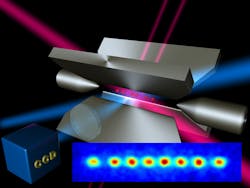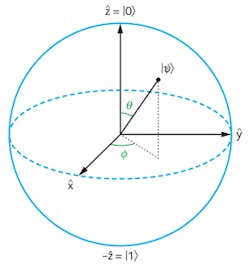Photonic Frontiers: Quantum Computing: In pursuit of quantum computing
Quantum computing made headlines twice in the first weeks of 2014. First documents leaked by Edward Snowden revealed that the National Security Agency seeks "a cryptographically useful quantum computer" as part of a $79.7 million program called "Penetrating Hard Targets."1 Days later, a paper posted on the Arxiv.org preprint Web site reported "no evidence of the [expected] quantum speedup" in tests of a quantum computer made by D-Wave Systems (Burnaby, BC, Canada).2
The real story behind the headlines is complex. Quantum-computing research is now two decades old, but it still seems a young field. Most research focuses on essential building blocks such as qubits, the quantum counterparts of the hardware bits in digital computers, which perform quantum operations. Other groups are developing paradigms for quantum computing and testing concepts for quantum error correction and quantum sensors. D-Wave builds quantum computers, but they are laboratory tools for exploring potential applications.
"We have come a long way, but probably have 15 to 20 years to go" before producing a full-scale quantum computer, says Carl J. Williams, chief of the Quantum Measurement Division at the National Institute of Standards and Technology (Gaithersburg, MD). If that sounds like a long time, remember that decades of development separated the original concept of general-purpose digital computers from the powerful ones working on our desks.
Allure of quantum computing
Quantum computing is based on manipulating qubits, quantum-mechanical superpositions of two states, such as two orthogonal polarizations of a photon. Figure 1 shows the conceptual difference between a digital bit, which can be either 0 or 1, and the superposition of a qubit. The idea is to perform quantum operations that alter the superposition without collapsing it. The potential power of such quantum processing increases with the number of qubits that can maintain coherence with each other; N qubits can represent 2N quantum states. Because qubits are quantum-mechanical objects, their values remain uncertain until the superposition of states collapses during the final readout stage.Quantum computing promises to be a very powerful tool for operations that are very difficult to perform on conventional digital computers. One important application is simulating the behavior of quantum-mechanical systems, such as a high-temperature superconductor or a complex molecule. Another potential application is rapid factoring of very large numbers, important to NSA and other security agencies because it can be used to crack digital encryption codes. Qubits also can be used in sensing. "An atomic clock in some ways is a one-qubit device," says Williams, and quantum devices also can serve as magnetometers and accelerometers. A long list of other applications also is being explored.
A young, diverse, and energetic field
After two decades, the field remains young and energetic, and much of the activity remains focused on developing a physical and conceptual groundwork.
The field grew from theoretical studies, particularly Peter Shor's algorithm for factoring large numbers,3 which predict that quantum-mechanical operations can perform certain tasks much faster than conventional digital computers. The challenge is to realize the potential "quantum speedup" in real-world devices.
Much of the experimental effort has gone into developing qubits. "You need quantum systems that can be easily manipulated and controlled to a high extent," says Rainer Blatt of the Quantum Optics and Spectroscopy group at the University of Innsbruck (Innsbruck, Austria). Scaling is essential-he says "there is a worldwide race to control as many qubits as you can." (See Frontis.) Some 15 to 18 technologies are being investigated as qubits, each with their advantages and limitations. Blatt's group is working on a qubit based on an optical transition of trapped ions of calcium-40.4
Trapped ion qubits "have exquisite coherence properties; they can be prepared and measured with nearly 100% efficiency; and they are readily entangled with each other through the Coulomb interaction or remote photonic interconnects," writes Chris Monroe of the Joint Quantum Institute (JQI; College Park, MD) in Science.5 His group is using ytterbium ions; other groups are studying other trapped ions. Both the Innsbruck and JQI groups have scaled experiments to 15 or 16 qubits, about halfway to the 30 qubits that Monroe says is needed to simulate behavior of a quantum-mechanical system too complex for digital computers to handle.
Other types of qubits may be better for other types of operations, says Klaus Ensslin of the Swiss Federal Institute of Technology (ETH; Zurich, Switzerland). Swiss researchers are studying many types of qubits for potential applications. One concern is the short lifetime of quantum states when they couple to the outside world. "To operate a quantum computer, you must isolate the quantum system from its environment, but you also must read it out," says Ensslin. The spin of the single electron in a quantum dot is attractive because it couples weakly to its environment. Quantum-dot pin qubits are hard to manipulate, but he says their big attraction is the possible ease of scaling in well-understood semiconductor nanostructures. Others are studying approaches where topological protection is quantum-engineered to enhance coherence and reduce noise.6 The scheme in Fig. 2 shows a pair of coupled quantum dots with controlled electron spins functioning as a qubit.Other types of qubits include:
• Neutral atoms and molecules with long-lived internal states, cooled, trapped, and entangled to create qubits.7
• Superconducting Josephson junction circuits.8
• Optical measurement of the quantum states of photons.9
• Nuclear magnetic resonance effects.
Paradigms for quantum computing
The first approach to quantum computation was a circuit-based approach like conventional digital computers, with electronic gates and circuits. Blatt still prefers this approach, in which the quantum computer starts with a certain input state and then performs a series of elementary operations on a few qubits at a time, much like conventional digital computers.
Several other approaches are also in development. Some are based on measurements, such as the "one-way" quantum computer that performs a series of single-bit measurements on an initial entangled cluster state. Others are quantum versions of classic cellular automata and Turing machines.
The approach furthest advanced into system development is the adiabatic computing or quantum annealing process used by D-Wave. It smoothly changes conditions in a quantum system containing many qubits so the solution to the problem can be read out at the end of the process.10 D-Wave has sold models containing over 500 qubits, so it has attracted considerable attention—plus criticism from skeptics who doubt the D-Wave machines can realize the theoretical benefits of quantum computing.
A preprint posted at Arxiv.org on January 12, 2014, reports that the hoped-for quantum speedup did not appear in benchmark tests of a 503-qubit D-Wave Two owned by Google. A team of nine information scientists led by Matthias Troyer of ETH Zurich wrote that the benchmark results "do not rule out the possibility of speedup for other classes and illustrate that quantum speedup is elusive and can depend on the question posed."1 The machine is worthwhile, says Blatt, who was not involved in the measurements, "but it is premature to call it a quantum computer."
The tests used in the benchmark study may not benefit from a quantum speedup, says Jeremy Hilton, vice president of processor development at D-Wave, citing another Arxiv paper.11 D-Wave continues to push ahead, with a 1000-qubit machine in the lab that it plans to release later this year. The sparse connectivity of qubits in the D-Wave machine also may have slowed the benchmark tests, say Google Quantum A.I. Team researchers involved in the study.12
Challenges and prospects
The NSA quantum-computing program did not surprise researchers in the field. They expect the agency to study a technology that might be able to crack data encryption systems, both to protect their own secure systems and to explore the vulnerabilities of other nations' systems. Indeed, NSA's own open electronic publication, The Next Wave, reported on the importance of quantum computing for encryption before Snowden's leaks.13
Development of quantum computing is taking time because it's a complex problem. "We need to be able to master quantum entities, and to put them into macroscopic systems, we need to do this bottom up," says Blatt. But the hard work is paying dividends. "I am surprised how much we have gained over the last three to four years," he says.
A key challenge in building a quantum computer is correcting for decoherence that creeps into the system and introduces noise. "People said it would never work because of decoherence. Now there are error correction protocols," says Ensslin, but "it seems you need to use a large fraction of the computing power for error correction." That's a much heavier overhead than in digital computing, but developing quantum error correction is a major step.
A roadmap for future development published in 2013 by Quantum Information Processing and Communication in Europe (quorpe.eu) sums it up: "At present no fundamental physical roadblocks seem in sight for building a scalable quantum computer including error correction. However, a mixture of significant technological challenges and some open physical questions remain to be answered."14 Quantum computing isn't going to be easy, but it could be within the technological horizon.
REFERENCES
1. S. Rich and B. Gellman, "NSA seeks to build quantum computer that could crack most types of encryption," Washington Post, see http://wapo.st/1deblQm (Jan. 2, 2014).
2. T. F. Rønnow, et al., "Defining and detecting quantum speedup," Arxiv.org, arXiv:1401.2910v1 (Jan. 13, 2014).
3. P. W. Shor, SIAM J. Comput., 26, 5, 1484 (1997); http://arxiv.org/abs/quant-ph/9508027v2.
4. P. Schindler et al., New J. Phys., 15, 123012 (2013); doi:10.1088/1367-2630/15/12/123012.
5. C. Monroe and J. Kim, Science, 339, 1164 (2013); doi:10.1126/science.1231298.
6. D. D. Awschalom et al., Science, 339, 1174 (2013); doi:10.1126/science.1231364.
7. J. I. Cirac and P. Zoller, Phys. Today, 38–44 (March 2004).
8. M. H. Devoret and R. J. Schoelkopf, Science, 339, 1169 (2013); doi:10.1126/science.1231930.
9. A. Politi et al., Science, 325, 1221 (2009).
10. E. Farhi et al., Science, 292, 472 (2001).
11. H. Katzgraber et al, "Glassy chimeras could be blind to quantum speedup: Designing better benchmarks for quantum annealing machines," Arxiv.org, arXiv:1401.1546 (Jan. 12, 2014).
12. Google Quantum A.I. Lab Team, "Where do we stand on benchmarking the D-Wave 2?" see http://bit.ly/1iQeJc1 (Jan. 19, 2014).
13. P. Lopata, "Beyond digital: a brief introduction to quantum computing," The Next Wave, National Security Agency, see http://1.usa.gov/1gupTDe (2013).
14. QUROPE, "Quantum information processing and communication: Strategic report on current status, visions and goals for research in Europe," see http://qurope.eu/content/roadmap (2013).
15. J. P. Kestner et al., Phys. Rev. Lett., 110, 140502 (2013)

Jeff Hecht | Contributing Editor
Jeff Hecht is a regular contributing editor to Laser Focus World and has been covering the laser industry for 35 years. A prolific book author, Jeff's published works include “Understanding Fiber Optics,” “Understanding Lasers,” “The Laser Guidebook,” and “Beam Weapons: The Next Arms Race.” He also has written books on the histories of lasers and fiber optics, including “City of Light: The Story of Fiber Optics,” and “Beam: The Race to Make the Laser.” Find out more at jeffhecht.com.


![FIGURE 2. One approach to reducing noise in quantum dot qubits is to couple a pair of them, each with a single electron. Pulsing voltage on the electrodes in a series of carefully designed steps can cancel out background effects to reduce errors while manipulating the quantum state of the electrons [15]. FIGURE 2. One approach to reducing noise in quantum dot qubits is to couple a pair of them, each with a single electron. Pulsing voltage on the electrodes in a series of carefully designed steps can cancel out background effects to reduce errors while manipulating the quantum state of the electrons [15].](https://img.laserfocusworld.com/files/base/ebm/lfw/image/2016/01/1403lfw03f2.png?auto=format,compress&fit=max&q=45&w=250&width=250)